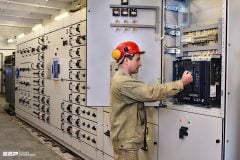Final location of the facility
At this stage, a footprint of the future power substation should be developed, including the layout of the major equipment. A decision on the final location of the facility can now be made and various options can be evaluated.

Final grades, roadways, storm water retention, and environmental issues are addressed at this stage, and required permits are identified and obtained.
Depending on local zoning ordinances, it may be prudent to make settlement on the property contingent upon successfully obtaining zoning approval since the site is of little value to the utility without such approval. It is not unusual for engineering, real estate, public affairs, legal, planning, operations, and customer service personnel along with various levels of management to be involved in the decisions during this phase.
The first round of permit applications can now begin! Although the zoning application is usually a local government issue, permits for grading, storm-water management, roadway access, and other environmental or safety concerns are typically handled at the state or provincial level and may be federal issues in the case of wetlands or other sensitive areas.
Other federal permits may also be necessary, such as those for aircraft warning lights for any tall towers or masts in the station.
Permit applications are subject to unlimited bureaucratic manipulation and typically require multiple submissions and could take many months to reach conclusion. Depending on the local ordinances, zoning approval may be automatic or may require hearings that could stretch across many months.
Zoning applications with significant opposition could take years to resolve.
Site evaluation criteria
As a rule of thumb, the following site evaluation criteria could be used:
- Economical evaluation
- Technical evaluation
- Community acceptance
Economical evaluation should address the level of affordability, return on investment, initial capital cost, and life cycle cost.
Technical aspects that can influence the site selection process could include the following:
- Land: choose areas that minimize the need for earth movement and soil disposal.
- Water: avoid interference with the natural drainage network.
- Vegetation: choose low productivity farming areas or uncultivated land.
- Protected areas: avoid any areas or spots listed as protected areas.
- Community planning: avoid urban areas, development land, or land held in reserve for future development.
- Community involvement: engage community in the approval process.
- Topography: flat but not prone to flood or water stagnation.
- Soil: suitable for construction of roads and foundations; low soil resistivity is desirable.
- Access: easy access to and from the site for transportation of large equipment, operators, and maintenance teams.
- Line entries: establishment of line corridors (alternatives: multi-circuit pylons, UG lines).
- Pollution: risk of equipment failure and maintenance costs increase with pollution level.
To address community acceptance issues it is recommended to:
- Adopt a low profile layout with rigid buses supported on insulators over solid shape steel structures.
- Locate substations in visually screened areas (hills, forest), other buildings, and trees.
- Use gas insulated switchgear (GIS).
- Use colors, lighting.
- Use underground egresses as opposed to overhead.
Other elements that may influence community acceptance are noise and oil leakages or spills.
To mitigate noise that may be emitted by station equipment, attention should be paid at station orientation with respect to the location of noise sensitive properties and use of mitigation measures such as noise barriers, sound enclosures, landscaping, and active noise cancellation.
Reference: Jim Burke (Baltimore Gas & Electric Company); Anne-Marie Sahazizian (Hydro One Networks, Inc.)











salut Edvard. years ago I saw your interesting portal.
Good Lock
Marcelo Palacios
Portoviejo Ecuador
Thank you Marcelo!
Now am working a project engineer in neev Energy . electrical engineering protal is good site for learn each and everything.
sir
i faced a problem in substation.i.e the around the station is getting sparks , what is the reason for this ,givbeme a solution